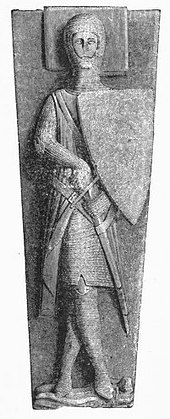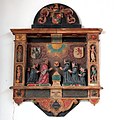Development
Medieval period
The earliest English church monuments were simple stone coffin-shaped grave coverings incised with a cross or similar design; the hogback form is one of the earliest types. The first attempts at commemorative portraiture emerged in the 13th century, executed in low relief, horizontal but as in life. Gradually these became full high-relief effigies, usually recumbent, as in death, and, by the 14th century, with hands together in prayer. In general, such monumental effigies were carved in stone, marble or wood, or cast in bronze or brass. Often the stone effigies were painted to resemble life, but on the vast majority of medieval monuments, the paint has long since disappeared. The cross-legged attitude of many armoured figures of the late 13th or early 14th centuries was long supposed to imply that the deceased had served in the Crusades, had taken crusading vows, or more specifically had been a Knight Templar; but these theories are now rejected by scholars. [1] [2] Feet were often supported by stylised animals, usually either a lion indicating valour and nobility (generally for men), or a dog indicative of loyalty (generally for women). [3] Sometimes the footrest was an heraldic beast from the deceased's family coat of arms.
By the early 13th century, the effigies were raised on tomb-style chests (known as tomb chests, altar tombs or table tombs) decorated with foliage, heraldry or architectural detailing. Soon such chests stood alone with varying degrees of decorations. By the end of the century, these often had architectural canopies. Small figures of weepers (often friends or relatives identified by their coats of arms) were popular decorative features. In the 15th century, the figures were often portrayed as angels or saints, and the chest might include a cadaver. The most refined monuments were made of alabaster. Around the 13th century, smaller two-dimensional effigies incised in plates of brass and affixed to monumental slabs of stone became popular too. These memorial brasses were somewhat cheaper and particularly popular with the emerging middle class.
Early modern period
The removal of almost all the many wall-paintings in English churches in the iconoclasm of the English Reformation and the English Commonwealth left plenty of bare spaces. Over the following centuries, these were gradually filled by monuments of the wealthy. It is the lack of competition from religious paintings and a tolerance of figurative sculpture in memorials, which most Protestant countries did not share, that produced the exceptionally rich English holdings of large sculptural church monuments.
In the 16th century, church monuments became increasingly influenced by Renaissance forms and detailing (pilasters, wreaths, strapwork, skulls, coffered arches, obelisks, allegorical figures, etc.), particularly in France, the Netherlands and, eventually, England. There were major innovations in effigial posture, the deceased often being shown reclining or kneeling in prayer and surrounded by the whole family, as in life. Cadavers were replaced by skeletons. The 'hanging' mural or wall monument also became popular, sometimes with half-length 'demi-figures'; and also the floor-bound heraldic ledger stone. The 17th century saw an increase in classicism and the use of marble. Effigies might be sitting or standing, grief-stricken, shrouded or, unusually, rising from the grave. Busts and relief portraits were popular. High Baroque monuments were some of the grandest ever constructed. Decoration turned to cherubs, urns, drapery, garlands of fruit and flowers. In the 18th century, church monuments became more restrained, placed before two-dimensional pyramids, but more Roman-like, with the deceased often depicted in Roman dress or as a cameo-like 'medallion portrait'. The Rococo style gave more movement to these figures.
Victorian period
The early 19th century brought Greek Revival monuments, some quite plain wall plaques, some with sentimental and romantically realistic figures (perhaps rising to heaven), or other devices such as weeping willows. Gothic Revival followed, with the obvious return to alabaster, tomb chests and recumbent effigies. However, the Victorian age saw many differing styles, until large-scale monuments fell out of fashion at the end of the century. 20th-century large-scale monuments are not unknown, but quite rare.

A cadaver monument or transi is a type of funerary monument to deceased persons featuring a sculpted tomb effigy of a skeleton, emaciated or decomposing dead body, with closed eyes. It was particularly characteristic of the Late Middle Ages when they were designed to remind viewers of the transience and vanity of mortal life, and the eternity and desirability of the Christian after-life. The format is in stark contrast to gisants, which are always recumbent, in full dress, with open eyes and hands clasped and raised in prayer.

A monumental brass is a type of engraved sepulchral memorial once found through Western Europe, which in the 13th century began to partially take the place of three-dimensional monuments and effigies carved in stone or wood. Made of hard latten or sheet brass, let into the pavement, and thus forming no obstruction in the space required for the services of the church, they speedily came into general use, and continued to be a favourite style of sepulchral memorial for three centuries.
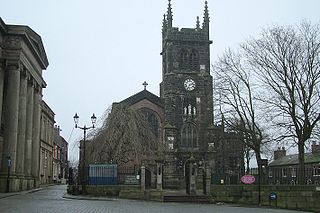
St Michael and All Angels Church overlooks Market Place in the town of Macclesfield, Cheshire, England. It is an active Anglican parish church in the diocese of Chester, the archdeaconry of Macclesfield and the deanery of Macclesfield. It forms a team parish with three other Macclesfield churches: All Saints, St Peter's and St Barnabas'. The church is recorded in the National Heritage List for England as a designated Grade II* listed building.

Funerary art is any work of art forming, or placed in, a repository for the remains of the dead. The term encompasses a wide variety of forms, including cenotaphs, tomb-like monuments which do not contain human remains, and communal memorials to the dead, such as war memorials, which may or may not contain remains, and a range of prehistoric megalithic constructs. Funerary art may serve many cultural functions. It can play a role in burial rites, serve as an article for use by the dead in the afterlife, and celebrate the life and accomplishments of the dead, whether as part of kinship-centred practices of ancestor veneration or as a publicly directed dynastic display. It can also function as a reminder of the mortality of humankind, as an expression of cultural values and roles, and help to propitiate the spirits of the dead, maintaining their benevolence and preventing their unwelcome intrusion into the lives of the living.

Nottingham alabaster is a term used to refer to the English sculpture industry, mostly of relatively small religious carvings, which flourished from the fourteenth century until the early sixteenth century. Alabaster carvers were at work in London, York and Burton-on-Trent, and many probably worked very close to the rural mines, but the largest concentration was around Nottingham. This has led to all the English medieval output being referred to as "Nottingham alabaster".
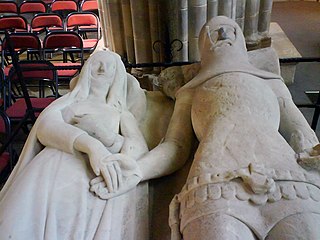
"An Arundel Tomb" is a poem by Philip Larkin, written and published in 1956, and subsequently included in his 1964 collection The Whitsun Weddings. It describes the poet's response to seeing a pair of recumbent medieval tomb effigies with their hands joined in Chichester Cathedral. It is described by James Booth as "one of [Larkin's] greatest poems". It comprises 7 verses of 6 lines each, each with rhyme scheme ABBCAC.
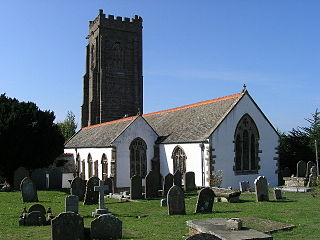
The Church of St Decuman in Watchet, Somerset, England has a 13th-century chancel with the rest of the church being from the 15th century. It has been designated as a Grade I listed building.

A tomb effigy is a sculpted effigy of a deceased person usually shown lying recumbent on a rectangular slab. Although these funerary and commemorative reliefs were first developed in Ancient Egyptian and Etruscan cultures, they appear most numerously in Western Europe tombs from the later 11th century, in a style that continued in use through the Renaissance and early modern period, and are still sometimes used. They typically represent the deceased in a state of "eternal repose", with hands folded in prayer, lying on a pillow, awaiting resurrection with a dog or lion at their feet. A husband and wife may be depicted lying side by side.

St Andrew's Church is a redundant Church of England parish church in the village of Wroxeter, Shropshire, England. It is recorded in the National Heritage List for England as a designated Grade I listed building, and is under the care of the Churches Conservation Trust. Both the village of Wroxeter and the church are in the southwest corner of the former Roman town of Viroconium.
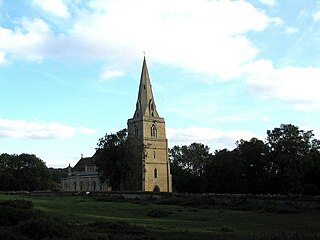
St Peter's Church is an Anglican church in the village of Deene, Northamptonshire, England. It is recorded in the National Heritage List for England as a designated Grade II* listed building, and is under the care of The Churches Conservation Trust and East Northamptonshire Council.

St Lawrence's Church is a redundant Anglican church in the parish of Snarford, Lincolnshire, England. It is recorded in the National Heritage List for England as a designated Grade I listed building, and is under the care of the Churches Conservation Trust. The church stands to the north of the A46 road between Market Rasen and Lincoln. It is a medieval building containing impressive 16th- and 17th-century monuments.
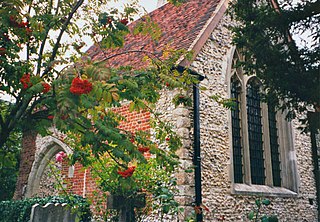
The Lumley Chapel is a redundant Anglican church in the suburban village of Cheam, in the London Borough of Sutton, England. It is recorded in the National Heritage List for England as a designated Grade II* listed building, and is under the care of the Churches Conservation Trust. The chapel is located in the churchyard of St Dunstan's Church in Church Road, off Malden Road, the A2043.

St Michael and All Angels' Church is a redundant Anglican church in the village of Thornton, Buckinghamshire, England. It is recorded in the National Heritage List for England as a designated Grade I listed building, and is under the care of the Churches Conservation Trust. The church stands to the north of the village, in the grounds of Thornton Hall, to the east of the River Ouse, some 4 miles (6 km) northeast of Buckingham.

St Mary's Watford is a Church of England church in Watford, Hertfordshire, in England. It is an active church situated in the town centre on Watford High Street, approximately 25 kilometres (16 mi) outside London. St Mary's is the parish church of Watford and is part of the Anglican Diocese of St Albans. Thought to be at least 800 years old, the church contains burials of a number of local nobility and some noteworthy monumental sculpture of the Elizabethan and Jacobean eras.

St Michael's Church at Chenies, Buckinghamshire, is a Grade I listed Anglican parish church in the Diocese of Oxford in England. It is not of great architectural interest but stands in an attractive position in the Chess Valley near the Chenies Manor House. The church is famous for its Bedford Chapel, the mausoleum of the Russell family which is private and not open to the public.

The large parish church of St Giles, which is in the village of St Giles in the Wood, Devon, England, came into being in 1309. When it was restored in 1862–3, many monuments were retained, including the monument and effigy of Thomas Chafe of Dodscott, three monumental brasses, of Alenora Pollard, Margaret Rolle of Stevenstone and a small brass of her husband John Rolle (d.1570). There are also 19th- and 20th-century monuments to the Rolle family.

A ledger stone or ledgerstone is an inscribed stone slab usually laid into the floor of a church to commemorate or mark the place of the burial of an important deceased person. The term "ledger" derives from the Middle English words lygger, ligger or leger, themselves derived from the root of the Old English verb liċġan, meaning to lie (down). Ledger stones may also be found as slabs forming the tops of tomb chest monuments.
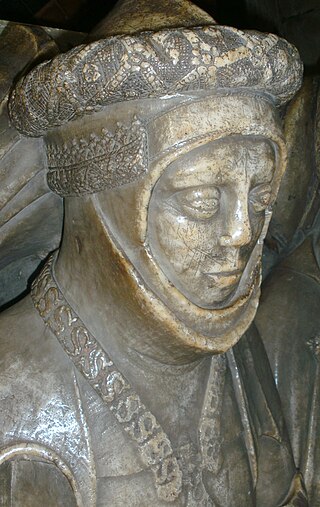
The orle was a decorative chaplet or wreath worn on helmets in Western Europe during the first half of the 15th century. There is a level of overlap of function and appearance with the torse, though the latter term implies a twisted pad made up of, usually, two contrasting colours of cloth.

Pleurants or weepers are anonymous sculpted figures representing mourners, used to decorate elaborate tomb monuments, mostly in the late Middle Ages in Western Europe. Typically they are relatively small, and a group were placed around the sides of a raised tomb monument, perhaps interspersed with armorial decoration, or carrying shields with this. They may be in relief or free-standing. In English usage the term "weepers" is sometimes extended to cover the small figures of the deceased's children often seen kneeling underneath the tomb effigy in Tudor tomb monuments.

The Church of All Saints in Radwell in Hertfordshire is an Anglican parish church which falls within the Diocese of St Albans. It is a Grade II* listed building, having gained that status in 1968.

